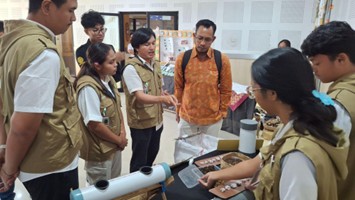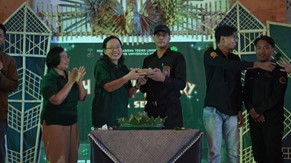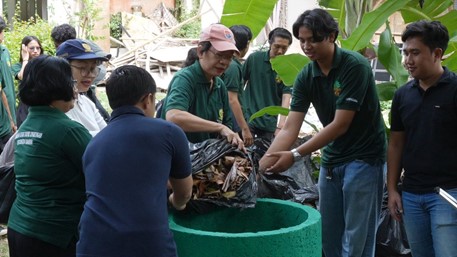Creation of Pilot Eco-Friendly Floating Net Cage with Fish Farmers Group for Conservation in Lake Batur Waters Area University General
The Udayana Servant Program Implementation Team carried out Focus Group Discussion (FGD) activities and Training on Making Pilot Eco-Friendly Floating Net Cages in the Lake Batur Area. The location of the service is the Lake Batur Waters Area in Trunyan Village, Kintamani District, Bangli Regency on June 18-19 2022. The participants involved in carrying out the activity were community representatives of the Fish Farmers Group in Lake Batur who came from Trunyan Village, Abang Batudinding Village, Desa Buahan, Kedisan Village and Abangsongan Village, a total of 20 people.
The Program Implementation Team consists of Lecturers and Students of the Environmental Engineering Study Program , Faculty of Engineering, Udayana University (Unud). Acting as Team Leader is Dr. Eng. Ni Made Pertiwi Jaya, ST., M.Sc. with members of the lecturer team, namely Ida Ayu Widhiawati, S.T., M.T., I Gede Andy Andika Parahita, S.Sc., M.Sc. and Ir. N. G. A. Khirsna Wiryanada, S.T., M.Sc., and 5 members of the student team.
The FGD was carried out by inviting the Fish Farmers Group in Lake Batur to hold discussions regarding a number of matters which became the background of the implementation of this community service activity, including data on lake water quality, lake pollutant conditions, conventional KJA waste, and lake water management. The executor of the activity conveys information related to the matters above and then proceeds with the submission of responses, input and suggestions from the community.
In the training activities, the participants who had previously been divided into 4 groups (5 people per group), were actively involved in carrying out the installation design, selecting plant species, preparing tools and materials, and assembling the installation. Participants in groups were asked to provide input on the initial design that had been given in the working paper, including the placement, use of Mechanical-Electrical equipment and the selection of plants which were then presented. This is done to obtain designs and installation examples that are in accordance with the conditions in the field. Changes or additions to the mutually agreed design are then outlined in the design drawings, both 2D and 3D. Preparation of tools and materials is carried out in accordance with the design and type of plant selected for the subsequent arrangement of equipment and placement in lake waters.
The evaluation is carried out at the end of the activity to find out the community's understanding regarding the management of water pollution and the performance of environmentally friendly KJA in terms of the effectiveness of the performance of the watertight pond, the reservoir for leftover fish feed, and the performance of the aquaponics system. Collecting information using a questionnaire form that was given to all participants.
Based on the results of the activity evaluation, it can be seen that the community, in this case the Fish Farmers Group in Lake Batur, can understand the pollution that occurs and the importance of managing water quality. Mr. Wayan Warjaya, as a fish farmer in Lake Batur said that this system is very good to be implemented in relation to lake water pollution, however, it needs to be thought about regarding the maintenance of this KJA system which is certainly not as easy as conventional KJA. The effectiveness of marine cages can also be seen from the performance of watertight ponds, fish feed waste storage, and the aquaponics system. In watertight ponds, sediment from leftover feed and faeces has accumulated at the bottom of the pond. Furthermore, wastewater pumped from impermeable ponds can be sucked up and collected in the reservoir provided. Aquaponic plants can also grow on plant media pipes that are placed on the side of the KJA.
The construction design concept of implementing a wastewater treatment plant in this environmentally friendly KJA with a biological filter consists of three main components, namely a watertight pond, a reservoir for leftover feed waste and an aquaponic plant. Based on the results of FGD activities involving the Fish Farming Group community in Lake Batur, it is possible to determine a watertight pond using a waterproof tarpaulin material with dimensions of 2 m x 2 m x 2 m with a water circulation window measuring 0.5 m x 0.25 m on both sides of the KJA , a reservoir for the remaining fish feed waste in the form of a water tank filtration drum with a volume of 250 L which is placed in the middle, as well as an aquaponics system using a 3-inch PVC pipe as a media pipe, planting medium, and pakcoy aquaponic plant seeds for a biological filter. The aquaponic system was made on the edge of floating net cage ponds with a wastewater treatment plant so that it is more flexible and does not interfere with the roads between plots and more pipes are used along the cages. Therefore, more plants can be planted, because high-economic crops used as biofilters can provide economic benefits for fish cultivating communities.




FACULTY OF ENGINEERING